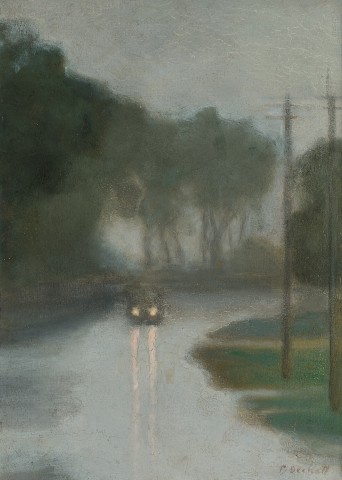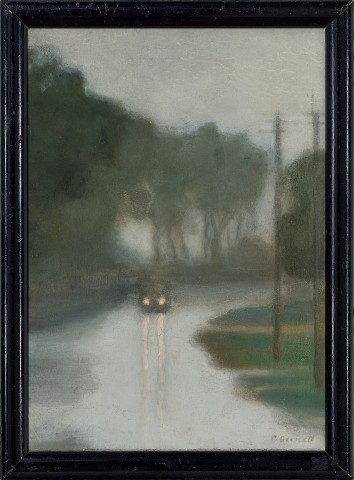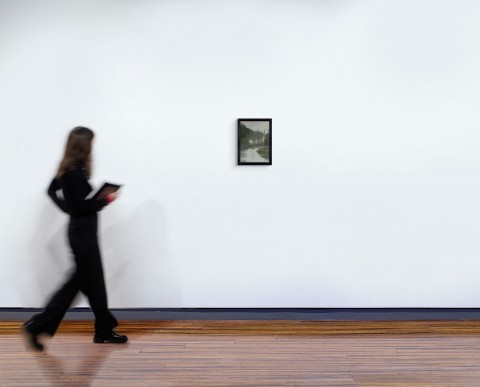BEACH ROAD, BEAUMARIS, c.1919
CLARICE BECKETT
oil on board
35.0 x 25.0 cm
signed lower right: C. Beckett
bears inscription verso: Beach Rd Beaumaris / ALAN MARTIN / 42 PARK RD / ELTHAM
bears inscription on label verso: Beach Road Beaumaris
Benjamin Dunbar Ratcliff, Melbourne
Thence by descent
Norman Dunbar Ratcliff, Melbourne
Alan and Lesly Martin, Melbourne, by bequest in the late 1950s
Thence by descent
Private collection, Melbourne
Paintings from the Martin Collection, The Eltham Community Centre, Melbourne, March 1985 (illus. in exhibition catalogue)
Clarice Beckett: Politically Incorrect, Ian Potter Museum of Art, University of Melbourne, Victoria; and touring to S.H. Ervin Gallery, Sydney, Orange Regional Gallery, New South Wales, Art Gallery of South Australia, Adelaide, Bendigo Art Gallery, Victoria, Tasmanian Museum and Art Gallery, Hobart, and Burnie Regional Art Gallery, Tasmania, 5 February 1999 – 22 May 2000, cat. 4 (label attached verso)
Hollinrake, R., Clarice Beckett: Politically Incorrect, Ian Potter Museum of Art, University of Melbourne, Victoria, 1999, cat. 4, pp. 15, 34 (illus.), 75
Eureka Street: A magazine of public affairs, the arts and theology, Melbourne, vol. 9, no. 4, May 1999, cover (illus.)
Beach Road after the rain (Street scene), c.1927, oil on cardboard, 35.5 x 25.5 cm, in the collection of the National Gallery of Victoria, Melbourne
We are grateful to Peter Perry for his assistance with this catalogue entry.
The first owner of Beach Road, Beaumaris was Benjamin Dunbar Ratcliff (1868 – 1956) – a successful businessman who was notably also the first major patron and collector of Max Meldrum’s French and Australian paintings, having been introduced to his work by the painter A.E. Newbury in 1916. Meldrum painted portraits of Ratcliff, his wife Jean Ratcliff and second born daughter Doris. As well as a collector of Meldrum’s work, Ratcliff financed the publication, Max Meldrum: His Art and Views edited by Colin Colahan and published by Alexander McCubbin in 1919. Ratcliff ran a thriving grocery business which by 1936 had expanded to twenty-two branches situated in various parts of Melbourne. In the early 1940s, the shops of ‘Ratcliff Bros.’ were sold to the grocery chain, Moran & Cato. Ratcliff was also an early significant patron of Clarice Beckett’s paintings having collected over twenty-five works from 1919 to 1933. Possibly to fund further grocery stores, Ratcliff started to sell part of his extensive art collection in 1933 through Joel Gallery at 362 Little Collins Street Melbourne – included in the offering were examples of Meldrum’s earlier French period, as well as a number of smaller Australian landscapes. Also for sale were eight landscapes by Clarice Beckett, together with paintings by Louis Buvelot, John Mather, Walter Withers, Louis McCubbin and Charles Wheeler.1 Almost ten years later in February 1942, Ratcliff again offered works by Meldrum and Beckett through Leonard Joel, having sold his large family home, Avondale at 22 Berkeley Street, Hawthorn to move into a smaller house in Camberwell.2
As to Beckett’s subject matter, art historian Siobhan Byford has written, ‘The reception of Beckett’s landscapes varied.’ To one critic, ‘her paintings were puzzling scenes of unsensational bits of suburban roads,’ yet to another more admiring commentator, Beckett ‘made the telegraph-pole artistically respectable… in her art, a tarred road… acquired a new beauty.’3 Moreover, as art critic and painter Alexander Colquhoun observed in his series Australian Artists Of To-Day, ‘A favourite subject with Miss Beckett is a wet suburban road reflecting a watery evening sky, with a motor car slipping ghost like into the mist, the only positive bit of colour being its vanishing tail light – an unambitious motive truly, but an indication that to the truly seeing eye beauty lies ever close at hand, and can be enjoyed without any arduous journeying in search of mountain scenery.’4
1. ‘Meldrum Pictures to be Sold’, The Age, Melbourne, 20 September 1933, p. 9
2. ‘Paintings by Max Meldrum’, The Argus, Melbourne, 25 February 1942, p. 2
3. Byford, S., Clarice Beckett (1887 – 1935): The Artist’s Life and Her Lost Exhibitions, 1887 to 1970, The University of Melbourne, Melbourne, April 2021, p. 43. See also: The Age, Melbourne, 26 November 1929, p. 9, and The Bulletin, Sydney, 28 October 1931, p. 18
4. ‘Australian Artists of To-Day, Miss Clarice Beckett by Alexander Colquhoun’, The Age, Melbourne, 18 July 1931, p. 7


